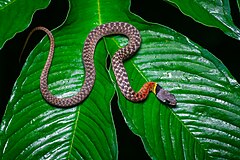Rhabdophis
| Rhabdophis[1] | |||
| Fitzionger, 1843[2] | |||
 Przedstawiciel rodzaju – szorstkogrzbiet czerwonoszyi (R. subminiatus) | |||
| Systematyka | |||
| Domena | eukarionty | ||
|---|---|---|---|
| Królestwo | zwierzęta | ||
| Typ | strunowce | ||
| Podtyp | kręgowce | ||
| Gromada | zauropsydy | ||
| Podgromada | diapsydy | ||
| Rząd | |||
| Podrząd | |||
| Infrarząd | Alethinophidia | ||
| Nadrodzina | Colubroidea | ||
| Rodzina | połozowate | ||
| Podrodzina | zaskrońcowate | ||
| Rodzaj | Rhabdophis | ||
| Typ nomenklatoryczny | |||
| Tropidonotus subminiatus Schlegel, 1837 | |||
| Synonimy | |||
| | |||
| Gatunki | |||
| |||
| |||
| |||
Rhabdophis – rodzaj węży z podrodziny zaskrońcowatych (Natricinae) w rodzinie połozowatych (Colubridae).
Zasięg występowania
Rodzaj obejmuje gatunki występujące w Azji (Rosja, Chiny, Tajwan, Korea Północna, Korea Południowa, Japonia, Indie, Sri Lanka, Nepal, Bhutan, Bangladesz, Mjanma, Laos, Wietnam, Kambodża, Tajlandia, Malezja, Filipiny, Brunei i Indonezja)[8].
Systematyka
Etymologia
- Rhabdophis: gr. ῥαβδος rhabdos „kij, laska, gałąź”[9]; οφις ophis, οφεως opheōs „wąż”[10].
- Steirophis: gr. στειρα steira „przednia część kilu”[11]; οφις ophis, οφεως opheōs „wąż”[10]. Gatunek typowy: Tropidonotus chrysargos Schlegel, 1837.
- Bothrodytes: gr. βοθρος bothros „otwór, dziura”[12]; δυτης dutēs „nurek”, od δυω duō „zanurzać się”[13]. Gatunek typowy: Tropidonotus subminiatus Schlegel, 1837.
- Macropisthodon: gr. μακρος makros „długi”[14]; οπισθεν opisthen „z tyłu, w tyle”[10]; οδους odous, οδοντος odontos „ząb”[15]. Gatunek typowy: Amphiesma flaviceps A.M.C. Duméril, Bibron & A.H.A. Duméril, 1854.
- Pseudagkistrodon: gr. ψευδος pseudos „fałszywy”[16]; rodzaj Agkistrodon Palisot de Beauvois, 1799. Gatunek typowy: Pseudagkistrodon carinatus Van Denburgh, 1909 (= Macropisthodon rudis Boulenger, 1906).
- Balanophis: gr. βαλανος balanos „żołądź”[17]; οφις ophis, οφεως opheōs „wąż”[10]. Gatunek typowy: Tropidonotus chrysargus var. ceylonensis Günther, 1858.
- Nuchisulcophis: łac. nuchus „szyja, kark”[18]; sulcus „bruzda, rowek”[19]; gr. οφις ophis, οφεως opheōs „wąż”[10]. Gatunek typowy: Tropidonotus nuchalis Boulenger, 1891.
Podział systematyczny
Do rodzaju należą następujące gatunki[8]:
- Rhabdophis adleri
- Rhabdophis akraios
- Rhabdophis angeli
- Rhabdophis auriculata
- Rhabdophis barbouri
- Rhabdophis callichroma
- Rhabdophis callistus
- Rhabdophis ceylonensis
- Rhabdophis chrysargoides
- Rhabdophis chrysargos
- Rhabdophis conspicillatus
- Rhabdophis flaviceps
- Rhabdophis guangdongensis
- Rhabdophis himalayanus
- Rhabdophis leonardi
- Rhabdophis lineatus
- Rhabdophis murudensis
- Rhabdophis nigrocinctus
- Rhabdophis nuchalis
- Rhabdophis pentasupralabialis
- Rhabdophis plumbicolor
- Rhabdophis rhodomelas – szorstkogrzbiet niebieskoszyi[20]
- Rhabdophis rudis
- Rhabdophis spilogaster
- Rhabdophis subminiatus – szorstkogrzbiet czerwonoszyi[20]
- Rhabdophis swinhonis
- Rhabdophis tigrinus – zaskroniec tygrysi
Przypisy
- ↑ Rhabdophis, [w:] Integrated Taxonomic Information System (ang.).
- ↑ a b L.J.F.J. Fitzinger: Systema reptilium. Fasciculus primus, Amblyglossae. Vindobonae: Braumüller et Seidel, 1843, s. 27. (łac.).
- ↑ E.D. Cope. An Analytical Table of the Genera of Snakes. „Proceedings of the American Philosophical Society”. 23, s. 495, 1886. (ang.).
- ↑ G.A. Boulenger: Catalogue of the snakes in the British Museum (Natural History). Cz. 1: Typhlopidae, Glauconiidae, Boidae, Ilysiidae, Ureopeltidae, Xenopeltidae, and Colubridae Aglyphae, part. London: The Trustees, 1893, s. 265. (ang.).
- ↑ J. Van Denburgh. New and previously unrecorded species of reptiles and amphibians from the island of Formosa. „Proceedings of the California Academy of Sciences”. Foutrh Series. 3, s. 51, 1909. (ang.).
- ↑ A.M. Smith. The nucho-dorsal glands of snakes. „Proceedings of the Zoological Society of London”. 107B, s. 575–583, 1938. (ang.).
- ↑ B.C. Mahendra. Handbook of the snakes of India, Ceylon, Burma, Bangladesh and Pakistan. „Annals of Zoology (Agra)”. 22 (B), s. 242, 1984. (ang.).
- ↑ a b P. Uetz & J. Hallermann: Genus: Rhabdophis. The Reptile Database. [dostęp 2019-07-27]. (ang.).
- ↑ Jaeger 1944 ↓, s. 195.
- ↑ a b c d e Jaeger 1944 ↓, s. 154.
- ↑ Jaeger 1944 ↓, s. 220.
- ↑ Jaeger 1944 ↓, s. 33.
- ↑ Jaeger 1944 ↓, s. 77.
- ↑ Jaeger 1944 ↓, s. 130.
- ↑ Jaeger 1944 ↓, s. 151.
- ↑ Jaeger 1944 ↓, s. xvii.
- ↑ Jaeger 1944 ↓, s. 29.
- ↑ Jaeger 1944 ↓, s. 148.
- ↑ Jaeger 1944 ↓, s. 225.
- ↑ a b Praca zbiorowa: Zwierzęta: encyklopedia ilustrowana. Warszawa: Wydawnictwo Naukowe PWN, 2005, s. 405. ISBN 83-01-14344-4.
Bibliografia
- Edmund C.E.C. Jaeger Edmund C.E.C., Source-book of biological names and terms, wyd. 1, Springfield: Charles C. Thomas, 1944, s. 1–256, OCLC 637083062 (ang.).










